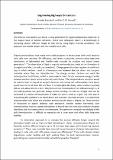Files in this item
Engineering highways for excitons
Item metadata
| dc.contributor.author | Ruseckas, Arvydas | |
| dc.contributor.author | Samuel, Ifor David William | |
| dc.date.accessioned | 2022-11-17T00:39:00Z | |
| dc.date.available | 2022-11-17T00:39:00Z | |
| dc.date.issued | 2021-11-17 | |
| dc.identifier | 276679447 | |
| dc.identifier | 65dd7835-4296-47ab-be8d-31c2134dc543 | |
| dc.identifier | 000723010700002 | |
| dc.identifier | 85124503042 | |
| dc.identifier.citation | Ruseckas , A & Samuel , I D W 2021 , ' Engineering highways for excitons ' , Joule , vol. 5 , no. 11 , pp. 2762-2764 . https://doi.org/10.1016/j.joule.2021.10.015 | en |
| dc.identifier.issn | 2542-4351 | |
| dc.identifier.other | ORCID: /0000-0001-9114-3522/work/103865422 | |
| dc.identifier.uri | https://hdl.handle.net/10023/26419 | |
| dc.description.abstract | The distance that excitons can travel is a key parameter for organic photovoltaic materials. In the August issue of Science Advances, Sneyd and colleagues report a breakthrough in increasing exciton diffusion length to 300 nm by using highly ordered nanofibers. This approach can enable simpler and more stable solar cells. | |
| dc.format.extent | 320021 | |
| dc.language.iso | eng | |
| dc.relation.ispartof | Joule | en |
| dc.subject | QC Physics | en |
| dc.subject | TK Electrical engineering. Electronics Nuclear engineering | en |
| dc.subject | T-NDAS | en |
| dc.subject | SDG 7 - Affordable and Clean Energy | en |
| dc.subject.lcc | QC | en |
| dc.subject.lcc | TK | en |
| dc.title | Engineering highways for excitons | en |
| dc.type | Journal article | en |
| dc.contributor.institution | University of St Andrews. School of Physics and Astronomy | en |
| dc.contributor.institution | University of St Andrews. Centre for Biophotonics | en |
| dc.contributor.institution | University of St Andrews. Condensed Matter Physics | en |
| dc.identifier.doi | 10.1016/j.joule.2021.10.015 | |
| dc.description.status | Peer reviewed | en |
| dc.date.embargoedUntil | 2022-11-17 |
This item appears in the following Collection(s)
Items in the St Andrews Research Repository are protected by copyright, with all rights reserved, unless otherwise indicated.

